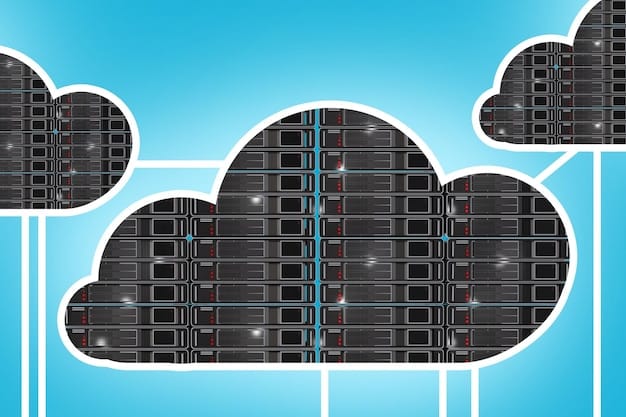Cloud Networking for Hybrid Cloud: Integrate US Infrastructure

Cloud networking for hybrid cloud enables US businesses to seamlessly integrate on-premise infrastructure with cloud resources, optimizing performance, security, and cost-efficiency through unified network management and connectivity solutions.
In today’s digital landscape, businesses are increasingly adopting hybrid cloud strategies to leverage the benefits of both on-premise infrastructure and cloud services. Cloud networking for hybrid cloud: seamlessly integrate your US on-premise infrastructure is the key to unlocking the full potential of this approach, ensuring secure, efficient, and reliable connectivity between your resources.
What is Cloud Networking for Hybrid Cloud?
Cloud networking for hybrid cloud refers to the technologies and strategies that enable seamless connectivity and management between an organization’s on-premise infrastructure and its cloud-based resources. This integration is crucial for businesses aiming to achieve agility, scalability, and cost-effectiveness in their IT operations.
It involves creating a unified network architecture that spans across both environments, allowing data and applications to move freely and securely. This approach ensures that organizations can leverage the best of both worlds: the control and security of on-premise infrastructure, and the flexibility and scalability of the cloud.

Key Components of Cloud Networking
Cloud networking solutions for hybrid cloud environments typically include several key components that work together to facilitate seamless integration and management.
- Virtual Private Networks (VPNs): VPNs create secure, encrypted connections between on-premise networks and cloud resources, ensuring data confidentiality and integrity during transmission.
- Software-Defined Networking (SDN): SDN technologies provide centralized control and management of network resources, allowing organizations to provision and manage network connections dynamically.
- Cloud Interconnects: Cloud interconnects offer dedicated, high-bandwidth connections between on-premise data centers and cloud providers, reducing latency and improving network performance.
- Network Security Tools: Security tools such as firewalls, intrusion detection systems, and data loss prevention (DLP) solutions are essential for protecting hybrid cloud environments from cyber threats.
In summary, cloud networking for hybrid cloud is about creating a cohesive and secure network environment that bridges the gap between on-premise and cloud resources, enabling organizations to optimize their IT infrastructure.
Benefits of Integrating US On-Premise Infrastructure with Cloud Networking
Integrating US on-premise infrastructure with cloud networking offers a multitude of benefits for businesses, ranging from improved efficiency and scalability to enhanced security and cost savings. By leveraging cloud networking, organizations can create a more agile and responsive IT environment.
The benefits extend beyond mere connectivity, enabling companies to optimize their operations, innovate faster, and stay competitive in today’s dynamic market. Cloud networking provides the tools and technologies necessary to manage a hybrid environment effectively.
Enhanced Scalability and Flexibility
One of the primary advantages of cloud networking is its ability to provide enhanced scalability and flexibility. Organizations can easily scale their resources up or down based on demand, without being constrained by the limitations of on-premise infrastructure.
This scalability is particularly beneficial for businesses experiencing rapid growth or seasonal fluctuations in demand. Cloud networking allows them to adapt quickly to changing business needs, ensuring they always have the resources they need to support their operations.
Improved Cost Efficiency
Cloud networking can also lead to significant cost savings. By leveraging cloud resources, organizations can reduce their capital expenditures on hardware and infrastructure. They can also optimize their operational expenses by paying only for the resources they use.
- Reduced Hardware Costs: Shifting workloads to the cloud reduces the need for expensive on-premise hardware.
- Optimized Resource Utilization: Cloud networking allows organizations to allocate resources more efficiently, avoiding over-provisioning.
- Lower Maintenance Costs: Cloud providers handle the maintenance and upkeep of cloud infrastructure, reducing the burden on internal IT teams.
Overall, the integration of on-premise infrastructure with cloud networking provides US businesses with a powerful combination of scalability, flexibility, and cost efficiency, enabling them to thrive in today’s competitive landscape.
Challenges of Hybrid Cloud Networking in the US
While cloud networking for hybrid cloud offers numerous benefits, it also presents several challenges that organizations must address to ensure successful implementation. These challenges range from security concerns and compliance requirements to network complexity and management overhead.
Understanding these challenges is crucial for businesses to develop effective strategies to mitigate risks and maximize the benefits of their hybrid cloud environment. Overcoming these hurdles requires careful planning, robust security measures, and skilled IT personnel.

Security and Compliance Concerns
Security is a top concern for organizations implementing hybrid cloud networking. Ensuring the security of data and applications across both on-premise and cloud environments requires a comprehensive security strategy and robust security tools.
Compliance is another critical consideration. Organizations must ensure that their hybrid cloud environment meets all relevant regulatory requirements, such as HIPAA, PCI DSS, and GDPR. This involves implementing appropriate security controls and data governance policies.
Network Complexity and Management Overhead
Managing a hybrid cloud network can be complex and time-consuming. Organizations must manage network connectivity, security, and performance across both on-premise and cloud environments.
This complexity can lead to increased management overhead and the need for specialized IT skills. Organizations may need to invest in training or hire skilled IT professionals to manage their hybrid cloud network effectively.
In conclusion, while the benefits of cloud networking for hybrid cloud are substantial, organizations must address the associated challenges to ensure a secure, compliant, and manageable environment. Careful planning and robust security measures are essential for success.
Best Practices for Seamless Integration of US Infrastructure
To ensure a seamless integration of US on-premise infrastructure with cloud networking, organizations should follow a set of best practices that focus on security, performance, and manageability. These practices are designed to help businesses maximize the benefits of their hybrid cloud environment while minimizing the risks.
Adhering to these best practices can streamline the integration process, reduce downtime, and improve overall operational efficiency. It also provides a solid foundation for future growth and innovation.
Establish a Robust Security Framework
A robust security framework is essential for protecting a hybrid cloud environment. This framework should include security policies, procedures, and tools that address all aspects of security, from network security to data security.
Organizations should implement security controls such as firewalls, intrusion detection systems, and data encryption to protect their data and applications. They should also conduct regular security assessments and penetration testing to identify and address vulnerabilities.
Optimize Network Performance
Optimizing network performance is crucial for ensuring a seamless user experience. Organizations should monitor network performance and identify bottlenecks that may be impacting application performance.
- Use Cloud Interconnects: Dedicated cloud interconnects provide high-bandwidth, low-latency connections between on-premise data centers and cloud providers.
- Implement Quality of Service (QoS): QoS policies prioritize network traffic based on application requirements.
- Monitor Network Performance: Use network monitoring tools to identify and address performance issues.
By following these best practices, US organizations can achieve a seamless integration of their on-premise infrastructure with cloud networking, enabling them to leverage the full potential of their hybrid cloud environment.
Tools and Technologies for Cloud Networking
Several tools and technologies are available to help organizations implement and manage cloud networking for hybrid cloud environments. These tools range from network virtualization platforms and software-defined networking (SDN) controllers to cloud management platforms and security tools.
Choosing the right tools and technologies is crucial for creating a robust, scalable, and secure hybrid cloud network. These tools can help organizations automate network management tasks, improve network visibility, and enhance security.
Network Virtualization Platforms
Network virtualization platforms such as VMware NSX and Cisco ACI allow organizations to create virtual networks that span across both on-premise and cloud environments. These platforms provide centralized control and management of network resources, making it easier to provision and manage network connections.
Network virtualization platforms also offer advanced security features such as micro-segmentation, which allows organizations to isolate workloads and restrict network access based on security policies.
Cloud Management Platforms
Cloud management platforms such as AWS Management Console, Azure Portal, and Google Cloud Console provide a centralized interface for managing cloud resources. These platforms allow organizations to provision, monitor, and manage their cloud resources from a single location.
Cloud management platforms often include features such as cost management, resource optimization, and security monitoring, helping organizations to optimize their cloud environment and reduce costs.
In summary, the right tools and technologies can significantly simplify the implementation and management of cloud networking for hybrid cloud, enabling organizations to achieve greater agility, scalability, and efficiency.
Future Trends in Cloud Networking for Hybrid Cloud in the US
The field of cloud networking is constantly evolving, with new technologies and trends emerging that are shaping the future of hybrid cloud environments. Understanding these trends is crucial for organizations to stay ahead of the curve and leverage the latest advancements in cloud networking.
These future trends promise to further enhance the capabilities of cloud networking, making it even more essential for businesses operating in hybrid cloud environments. By embracing these trends, organizations can create more efficient, secure, and scalable networks.
Artificial Intelligence (AI) and Machine Learning (ML)
AI and ML are increasingly being used to automate network management tasks, improve network performance, and enhance security. AI-powered network monitoring tools can analyze network traffic patterns and identify anomalies that may indicate a security threat or performance issue.
ML algorithms can also be used to optimize network routing and resource allocation, improving network performance and reducing costs.
Edge Computing
Edge computing involves processing data closer to the source, reducing latency and improving application performance. In hybrid cloud environments, edge computing can be used to process data on-premise or at the edge of the network, while still leveraging cloud resources for storage and analysis.
| Key Point | Brief Description |
|---|---|
| 🔑 Seamless Integration | Connect US on-premise infrastructure effortlessly with cloud resources. |
| ☁️ Enhanced Scalability | Scale resources dynamically based on demand, optimizing costs. |
| 🛡️ Robust Security | Ensure data protection with comprehensive security measures. |
| 🤖 AI and ML Integration | Leverage AI/ML for automated network management and optimization. |
Frequently Asked Questions (FAQ)
▼
Hybrid cloud networking connects an organization’s on-premise infrastructure with cloud-based resources, creating a unified and seamless environment for data and applications.
▼
Integration improves scalability, flexibility, and cost-efficiency, allowing businesses to leverage the best of both on-premise and cloud environments for their IT needs.
▼
Key components include VPNs, SDN, cloud interconnects, and network security tools, all working together to create a secure and efficient hybrid cloud environment.
▼
Implement a robust security framework with firewalls, intrusion detection systems, and data encryption, and conduct regular security assessments to identify and address vulnerabilities.
▼
Future trends include the use of AI and ML for network automation and optimization, as well as the adoption of edge computing to reduce latency and improve application performance.
Conclusion
In conclusion, cloud networking for hybrid cloud is essential for US businesses looking to seamlessly integrate their on-premise infrastructure with cloud services. By understanding the benefits, challenges, and best practices, organizations can create a secure, efficient, and scalable hybrid cloud environment that supports their business goals.





